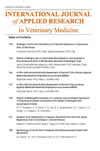苏丹的兽医教育和服务:挑战和可能的解决办法
4区 农林科学
Q4 Veterinary
International Journal of Applied Research in Veterinary Medicine
Pub Date : 2023-10-05
DOI:10.31893/avr.2023018
引用次数: 0
摘要
畜牧业在苏丹经济和全体人民的福利中发挥着关键作用。尽管该部门对人民的生计做出了重大贡献,但苏丹的兽医服务和教育环境一直面临着严峻的挑战。然而,没有关于该国兽医部门面临的挑战的文献。本研究的目的是确定和记录苏丹兽医服务和教育面临的挑战及其可能的解决方案。在Microsoft Forms平台上进行了一项结构化问卷调查。调查问卷包括通过社交媒体分发的关于参与者人口统计、兽医职业挑战和潜在解决方案的封闭式问题。共有357名参与者分别通过30个和29个多重响应的优先级确定了挑战和解决方案。被确定的主要挑战是兽医部门不优先(57.4%),兽医专业人员迁移(55.7%),兽医部门资源配置不足(53.8%),非专业人员从事兽医工作(52.4%),领导和管理薄弱(50.4%)。建议的主要解决方案包括培训和能力建设(76.8%)、传播动物福利文化(62.7%)、适用动物福利法(62.5%)、优先考虑兽医部门(61.6%)和改善卫生保健基础设施(61.1%)。我们得出结论,大多数问题及其解决方案在于兽医职业的优先级,兽医专业人员的迁移,资源的分配,领导和管理,文化和动物福利法的应用。为了更好的兽医专业成果,这些应该被给予最高的优先权。本文章由计算机程序翻译,如有差异,请以英文原文为准。
Veterinary medicine education and services in Sudan: Challenges and potential solutions
The livestock sector plays a critical role in the Sudanese economy and the welfare of the whole population. Despite the sector’s significant contribution to peoples’ livelihoods, the veterinary services and education environment has always faced daunting challenges in Sudan. However, there is no literature on the challenges faced by the veterinary sector in the country. The purpose of this study was to identify and document veterinary services and education challenges and their potential solutions in Sudan. A structured questionnaire survey was conducted and hosted online on the Microsoft Forms platform. The questionnaire comprised closed questions on participants’ demographics, veterinary profession challenges and potential solutions that were distributed through social media. A total of 357 participants identified the challenges and solutions through the prioritization of 30 and 29 multiple responses, respectively. The main top challenges identified were not giving priority to the veterinary sector (57.4%), migration of veterinary professionals (55.7%), inadequate allocation of resources to the veterinary sector (53.8%), practice of veterinary medicine by nonprofessional people (52.4%), and weak leadership and management (50.4%). The leading solutions suggested included training and capacity building (76.8%), spreading the culture of animal welfare (62.7%), application of the Animal Welfare Law (62.5%), giving priority to the veterinary sector (61.6%), and improving healthcare infrastructure (61.1%). We conclude that most problems and their solutions lie within the prioritization of the veterinary profession, veterinary professional migration, allocation of resources, leadership and management, culture and application of the Animal Welfare Law. These should be accorded the highest priority for better veterinary profession outcomes.
求助全文
通过发布文献求助,成功后即可免费获取论文全文。
去求助
来源期刊
自引率
0.00%
发文量
1
审稿时长
3 months
期刊介绍:
The International Journal of Applied Research in Veterinary Medicine promotes excellence in the clinical practice of veterinary medicine by disseminating fundamental scientific, diagnostic, and treatment knowledge gained from prospective and retrospective research in a timely manner. The Journal fulfills its mission through rapid peer review of each submitted article, and publication of all articles within 90 days of acceptance. All published articles meet the standards of Balance, Independence, Objectivity and Scientific Rigor.

 求助内容:
求助内容: 应助结果提醒方式:
应助结果提醒方式:


